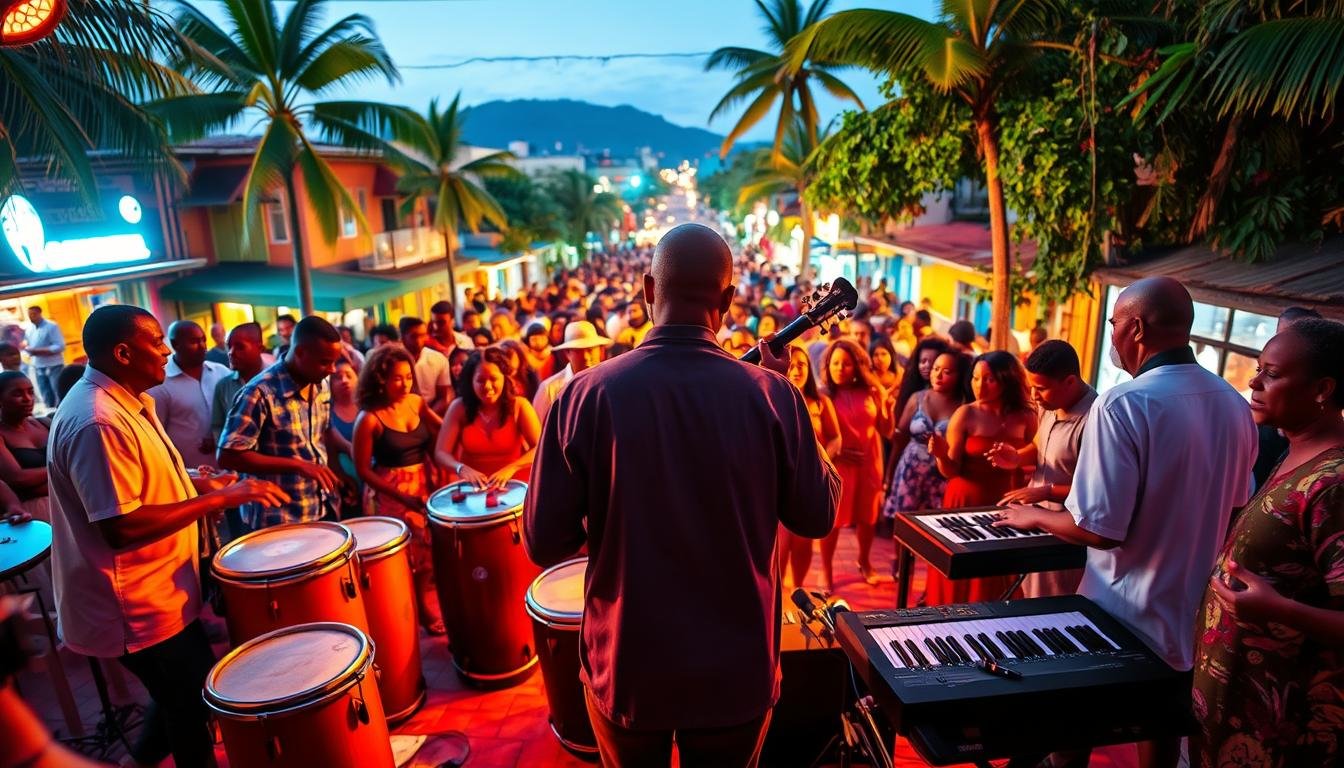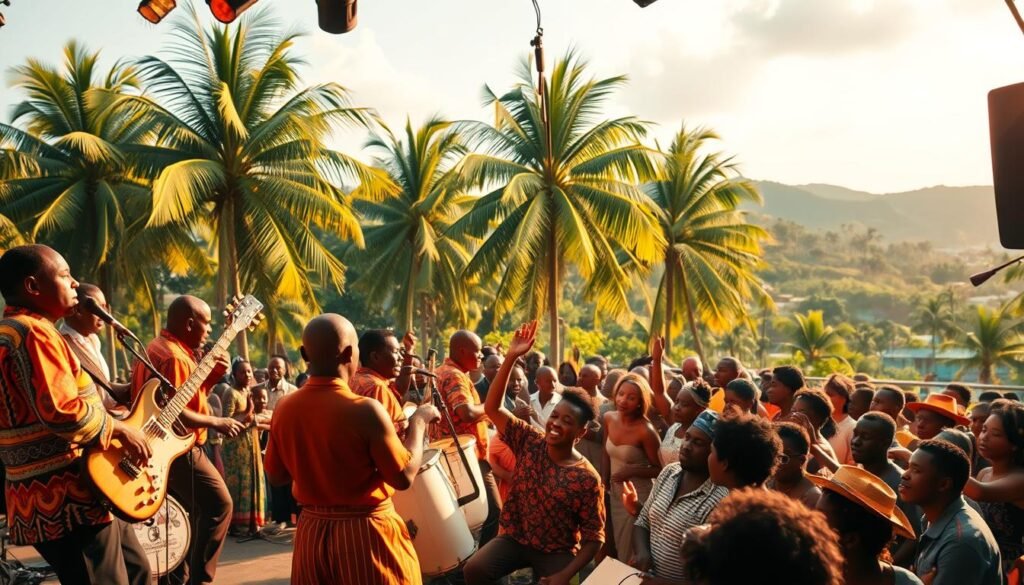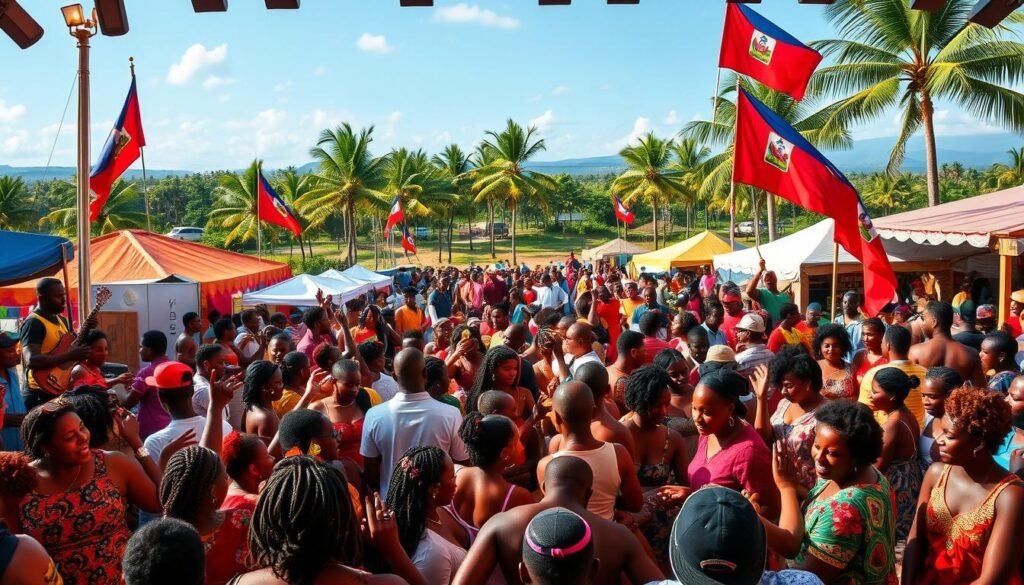Physical Address
304 North Cardinal St.
Dorchester Center, MA 02124
Physical Address
304 North Cardinal St.
Dorchester Center, MA 02124

Discover the vibrant world of Haitian Kompa music, a captivating blend of Caribbean rhythms and cultural influences.
Haitian Kompa Music has been a staple of Caribbean rhythms for decades, captivating audiences with its unique blend of traditional Haitian music and modern influences. This genre has a rich Kompa history that reflects the cultural heritage of Haiti.
Kompa music is more than just a style; it’s a representation of Haitian culture and its resilience. The genre has evolved over time, incorporating various musical elements while maintaining its traditional roots.
The birth of Kompa music in Haiti is a fascinating story that intertwines cultural heritage and musical innovation. Emerging in the 1950s, Kompa has its roots deeply embedded in Haitian culture and history.
Kompa music was born out of the traditional Haitian meringue and other Caribbean musical styles. The genre was characterized by its fast-paced rhythm and the use of modern instrumentation, making it a unique sound that captivated the Haitian audience. Key characteristics of early Kompa include:
Nemours Jean-Baptiste is credited as the founder of Kompa music. His band, Conjunto International, played a pivotal role in popularizing the genre not just in Haiti but across the Caribbean. Jean-Baptiste’s innovative approach to blending traditional Haitian music with contemporary styles laid the foundation for what would become a cultural phenomenon.
The 1950s was a period of significant political and social change in Haiti. Kompa music emerged as a form of expression and resistance, reflecting the aspirations and struggles of the Haitian people. The genre became a powerful medium for voicing dissent and hope, resonating with a population seeking change.
By understanding the origins and historical context of Kompa, we gain insight into its significance as a cultural and musical phenomenon in Haiti and beyond.
The musical characteristics of Kompa are a reflection of its Haitian roots and cultural heritage. This genre is known for its captivating rhythms and instrumentation, which have evolved over time while maintaining their traditional essence.
Kompa is characterized by its fast-paced and energetic rhythmic patterns. The tempo is typically upbeat, making it a staple at Haitian gatherings and celebrations. The rhythm is driven by a combination of percussion instruments, creating a unique Caribbean rhythm that is both infectious and lively.
The instrumentation in traditional Kompa includes a mix of traditional and modern elements. Key instruments include the drum, saxophone, and guitar, which together create the genre’s distinctive sound. The use of these instruments contributes to the rich musical texture that defines Kompa.
Lyrically, Kompa songs often focus on themes of love, social issues, and cultural identity. The language used is predominantly Haitian Creole, which adds to the genre’s authenticity and emotional resonance.
Creole expressions play a crucial role in Kompa lyrics, conveying emotions and stories in a way that is deeply relatable to Haitian audiences. The use of Creole not only preserves the cultural heritage but also enriches the musical experience.
| Instrument | Role in Kompa | Contribution to Sound |
|---|---|---|
| Drum | Provides the core rhythm | Energizes the music |
| Saxophone | Adds melodic depth | Enhances the emotional impact |
| Guitar | Supports harmonic structure | Adds complexity to the rhythm |
The combination of these elements results in the vibrant sound of traditional Kompa, a genre that continues to captivate audiences with its unique Kompa musical characteristics and rich cultural heritage.
The vibrant rhythms of Kompa have become synonymous with Haitian heritage, reflecting the nation’s history and resilience. Kompa music is more than just a genre; it’s a cultural identifier that resonates deeply within Haitian society.
Kompa’s cultural significance extends beyond its entertainment value, as it plays a crucial role in shaping Haitian identity. The music’s ability to evoke emotions and memories makes it a powerful tool for storytelling and cultural preservation.
For Haitians, Kompa is a source of national pride, symbolizing the country’s rich cultural heritage. The genre has been embraced by Haitians worldwide, serving as a connection to their roots and a celebration of their identity.
Kompa is a staple at Haitian community gatherings, including festivals, weddings, and other celebrations. Its energetic rhythms bring people together, creating a sense of unity and joy.
| Aspect | Description | Impact |
|---|---|---|
| Cultural Significance | Kompa reflects Haitian history and culture | Preserves national identity |
| National Pride | Kompa symbolizes Haitian heritage | Fosters unity among Haitians |
| Community Gatherings | Kompa is central to celebrations | Brings people together |
The evolution of Kompa is a story of cultural resilience and musical innovation, shaped by Haiti’s complex history. Over the years, Kompa has adapted to changing social, political, and technological landscapes, ensuring its continued relevance and popularity.
The 1960s and 1970s are often referred to as the “Golden Age” of Kompa. During this period, big bands became the norm, with groups like Tabou Combo and Skillet Akord dominating the scene. These bands introduced a more sophisticated sound, incorporating complex arrangements and a larger number of musicians. The big band era not only elevated the status of Kompa within Haiti but also helped spread its popularity internationally.
The 1980s and 1990s were marked by significant political turmoil in Haiti, which had a profound impact on Kompa music. Artists began to use their music as a form of social commentary and resistance. The genre continued to evolve, with some artists incorporating new instruments and styles while maintaining the core rhythms that defined Kompa.
In the 2000s, Kompa entered a new era with the advent of digital music production. Artists could now produce high-quality recordings without the need for expensive studio equipment. This shift, combined with the rise of streaming platforms, allowed Kompa to reach a global audience like never before.
The internet and streaming platforms have been instrumental in Kompa’s global dissemination. Artists can now share their music worldwide, and fans can access Kompa music from anywhere. This has not only expanded Kompa’s fan base but also influenced its development, with artists incorporating international styles and collaborating with musicians from other genres.
In conclusion, the evolution of Kompa through the decades reflects both the challenges faced by Haitian society and the resilience of its cultural expressions. As Kompa continues to adapt to new technologies and global influences, it remains a vibrant and essential part of Haitian identity.
The rich history of Kompa is marked by iconic figures who have left an indelible mark on the genre. These legendary artists have not only shaped the sound of Kompa but have also played a significant role in its global popularity.
Tabou Combo is one of the most renowned Kompa bands, known for their energetic performances and classic hits. As ambassadors of Kompa, they have toured extensively and introduced the genre to new audiences worldwide. Their music embodies the spirit of Kompa, blending traditional rhythms with modern styles.
Sweet Micky, whose real name is Michel Martelly, is a celebrated Kompa artist who later transitioned into politics, great musician but terrible politician, becoming the President of Haiti. His musical career was marked by innovative compositions and charismatic stage presence, earning him a large following. Martelly’s influence on Kompa extends beyond his music, as he helped popularize the genre among a broader audience.
“Kompa is not just music; it’s a cultural expression that unites people.”
T-Vice and Carimi are contemporary Kompa bands that have made significant contributions to the genre. They have modernized Kompa while maintaining its traditional essence, appealing to both old and new fans. Their innovative approach has helped keep Kompa vibrant and relevant in the modern music scene.
While Kompa has been predominantly male-dominated, female artists have made important contributions. Singers like Erzulie Francoeur and Tasha Cherie have brought unique perspectives and talents to the genre, enriching its diversity and depth.
The legacy of these legendary Kompa artists continues to inspire new generations of musicians and fans alike, ensuring the genre’s continued evolution and popularity.
The diversity within Kompa is evident through its regional variations and related genres. Over time, Kompa has branched out, influenced by various cultural and musical factors.
Cadence Rampa emerged as a significant style within Kompa, characterized by its fast-paced rhythm. The Mini-Jazz movement, popular in the 1960s and 1970s, further energized the Kompa scene with smaller, more agile bands.

Zouk, a genre originating from the French Caribbean, shares a close relationship with Kompa. The fusion of Zouk and Kompa has resulted in a unique sound that appeals to a broader audience.
Within the Kompa genre, distinctions are made between Compas Direct and Compas Love. Compas Direct is characterized by its straightforward, energetic rhythm, while Compas Love is often associated with a more romantic and melodic style.
The exploration of these regional variations and related genres highlights the dynamic nature of Kompa, showcasing its ability to evolve while maintaining its cultural significance.
As Haitians migrated, they took their love for Kompa music with them, creating vibrant communities abroad. The Haitian diaspora has played a crucial role in spreading Kompa globally, with cities like New York, Miami, and Montreal becoming hubs for Kompa enthusiasts.
New York City, with its large Haitian population, has a thriving Kompa scene. The city hosts numerous Kompa events and concerts, attracting fans from across the northeastern United States. Tabou Combo, a legendary Kompa band, has a special connection to New York, having performed there multiple times.
Miami, known for its significant Haitian community, is another hotspot for Kompa. The city’s cultural events often feature Kompa music, drawing large crowds. South Florida’s Haitian enclaves have become essential in preserving and promoting Kompa culture.
Montreal, Canada, has a unique Kompa scene influenced by French-Canadian culture. The city’s Haitian community has adapted Kompa to local tastes while maintaining its Haitian roots. This blend has contributed to the evolution of Kompa, making it more diverse.
The Haitian diaspora is not only preserving Kompa but also evolving it. By incorporating new styles and collaborating with artists from other genres, the diaspora is ensuring Kompa remains relevant and vibrant. This evolution is crucial for the genre’s survival and global appeal.
Kompa festivals and events are essential to experiencing the lively spirit of Haitian music and culture. These gatherings celebrate the genre’s rich history, vibrant energy, and the community that comes together to enjoy live music and dance.
The Kompa Festival in Haiti is a significant event that showcases the best of Haitian music, featuring renowned artists and new talent. It’s a celebration of Kompa’s cultural significance and its role in Haitian society.
The Haitian Compas Festival in Miami brings together the Haitian diaspora to enjoy live Kompa music, dance, and culture. It’s an opportunity for the community to come together and celebrate their heritage.
The New York Haitian Music Awards recognize and honor outstanding achievements in Haitian music, including Kompa. The event highlights the genre’s importance and its artists’ contributions.
To experience live Kompa in the United States, one can attend festivals like the Haitian Compas Festival in Miami or the New York Haitian Music Awards. These events offer a chance to enjoy live music, dance, and connect with the Haitian community.
| Event | Location | Description |
|---|---|---|
| Kompa Festival | Haiti | Celebrates Haitian music and culture |
| Haitian Compas Festival | Miami | Brings together the Haitian diaspora for music and dance |
| New York Haitian Music Awards | New York | Honors achievements in Haitian music |

Learning Kompa dance is not just about mastering steps; it’s about embracing a culture. Kompa, with its rich history and captivating rhythms, offers a unique dance experience that combines energetic movements with intimate couple dancing.
Kompa dance is characterized by its smooth, gliding steps and rhythmic hip movements. The basic step involves a simple forward and backward movement, but the dance becomes more complex with the addition of turns and dips. Mastering the basic step is essential before moving on to more intricate patterns.
One of the defining features of Kompa dance is its intimate connection between partners. It’s a dance that requires trust, communication, and harmony between the couple. As one dancer noted,
“Kompa is not just a dance; it’s a conversation between two people through movement.”
For those in America looking to learn Kompa, there are several options. Many dance schools offer Kompa classes, especially in cities with large Haitian communities like New York and Miami.
In addition to local dance schools, there are numerous online resources, including video tutorials and online classes. YouTube channels dedicated to Kompa dance are a great place to start. Local dance events and festivals also provide opportunities to learn from experienced dancers.
Embracing Kompa music today involves more than just listening; it’s about understanding its essence and exploring its many dimensions. For both new and seasoned listeners, there’s a wealth of resources available to dive deeper into this vibrant genre.
Starting your Kompa journey can be simplified by exploring iconic albums. Tabou Combo’s “L’Indomptable” and Nemours Jean-Baptiste’s “Konpa Manbo” are must-listens that showcase the genre’s evolution.
Kompa music is readily available on various streaming platforms like Spotify, Apple Music, and YouTube Music. Additionally, radio stations catering to Haitian communities often feature Kompa playlists.
Following Kompa artists and enthusiasts on social media platforms like Facebook, Instagram, and Twitter can provide insights into new releases and upcoming events.
Whether you’re looking for energetic tracks for a workout or smooth melodies for a relaxed evening, Kompa playlists can be tailored to suit various moods. A sample playlist might include:
| Occasion | Recommended Artists | Playlist Mood |
|---|---|---|
| Workout | Tabou Combo, T-Vice | Energetic |
| Relaxing Evening | Carimi, Sweet Micky | Laid-back |
| Party | Nemours Jean-Baptiste, Skah Shah | Vibrant |
By exploring these resources, listeners can enrich their Kompa experience and connect with a broader community of fans.
Haitian Kompa has established itself as a vibrant and dynamic genre, deeply rooted in Haitian culture. Its rich history, from the 1950s to the present day, has been marked by significant milestones and legendary artists who have contributed to its global appeal.
The Kompa legacy continues to thrive, with its influence evident in various musical styles and its presence felt in community gatherings and celebrations. As the genre evolves, it remains an essential part of Haitian identity and national pride.
Looking to the future of Kompa, it’s clear that the genre will continue to adapt and grow, incorporating new sounds and styles while maintaining its traditional roots. The global Haitian diaspora plays a crucial role in preserving and promoting Kompa, ensuring its continued relevance and popularity.
As a cultural phenomenon, Haitian Kompa embodies the spirit and resilience of the Haitian people, making it an integral part of the country’s heritage. Its enduring legacy is a testament to the power of music to unite and inspire communities worldwide.